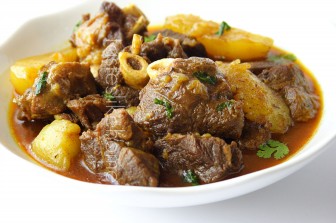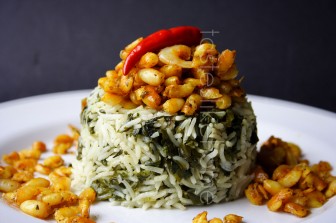Hi Everyone,
“A lot of people don’t realize that there is a difference between bunjal and curry you know,” declared the winner of last year’s Duck Curry Competition put on by the Guyanese Association of Barbados (GABI). It is a comment that I have heard repeated all my life, especially by cooks who consider themselves to be curry aficionados.
My mother got so upset one day when my sister made shrimp curry instead of bunjal shrimp. After the lecture I can tell you, my sister never made that mistake again. And I ensured that I never dared to make such a mistake either.
 So what is bunjal? Isn’t it a curry? Technically speaking, yes, a bunjal is a curry but it is a particular type of curry. Bunjal is a dry curry. The meat or poultry is cut sometimes smaller than it is for curry and it is cooked in the curry paste low and slow along with its own juices until all the liquid has evaporated and all that is left is the meat coated with the paste and oil from its cooked down state. Some people add water to aid the cooking process but even if they do, they add very little water and the finished dish is always dry, there is no sauce or gravy. Covering the pan is key when cooking bunjal as it helps the dish to develop steam and its own moisture to cook the ingredients.
So what is bunjal? Isn’t it a curry? Technically speaking, yes, a bunjal is a curry but it is a particular type of curry. Bunjal is a dry curry. The meat or poultry is cut sometimes smaller than it is for curry and it is cooked in the curry paste low and slow along with its own juices until all the liquid has evaporated and all that is left is the meat coated with the paste and oil from its cooked down state. Some people add water to aid the cooking process but even if they do, they add very little water and the finished dish is always dry, there is no sauce or gravy. Covering the pan is key when cooking bunjal as it helps the dish to develop steam and its own moisture to cook the ingredients.

A curry on the other hand is meat cooked with the curry paste to which water is added. The curry is cooked to such a state that when the meat or poultry is finished cooking, there is enough liquid left in the pot that forms the curry sauce or gravy. This sauce/gravy is usually silky and thick in that it can coat a spoon. Please be very clear that I am not talking here about a long-water curry! My brother likes long-water curry. I can’t stand a long water curry or stew.
Long water curry is when a curry is cooked with so much water that the meat, poultry or seafood is fully cooked but the sauce has not been allowed to reduce until it thickens. When you put this type of curry on top of rice, all you see at the top is the meat and the sauce has disappeared between the rice to the bottom of the plate. You have nothing to coat the rice with as you eat. You see why I don’t like long-water curry?

One can bunjal anything – meat, poultry or seafood. Bunjal is best served with dhal because there is enough of a sauce-like environment from the dhal. Hence people cook dhal and rice with bunjal shrimp, duck, beef, chicken or pork. Or you can make bunjal dishes to be served as wraps or with sautéed vegetables or one-pot rice dishes such as rice and peas, bhajee rice or some other type of vegetable rice. Bunjal dishes are also ideal to be served as cutters when there are get-togethers. I remember bowls of bunjal beef and mutton at many of our extended family gatherings. Apart from preparing a feast for the big meal the men and women folk always ensured that cutters were prepared in adequate quantities. Sometimes there would be bunjal wild meat too, such as labba. Once wild meat was involved – I don’t know if it is a guy thing – but one of the men in our family would always opt to cook the wild meat, it’s as if they had some special magic touch to bring to the bunjal wild meat. But I digress.
A curry can be eaten without assistance from any other sauce because it comes with its own sauce. When a dish of curry and rice is served, you see the thick sauce spread over the rice and clinging to it. When you mix the sauce and rice together – whether with your fingers, spoon, fork or knife and fork, you have two elements to mix together.
Curry is ideal also for roti and other types of flat breads or even regular yeasted breads; there is sauce to be mopped up. There is something for the roti or bread to adhere to.
So the next time you set out to make a curry, think about what type of curry you are making or that you want to make – bunjal (dry) or curry (with gravy). You may ask, is there a difference in the taste? The flavour profile in a bunjal is a bit more intense given that everything gets absorbed back into the meat (or main ingredient), while in a curry, the flavour is shared between the meat and the sauce.
As I write this, two other words come to mind when we talk about curry in particular – chunkay and bounjay. The women in my family say, to chunkay the curry is to add the curry paste (made of garam masala and aromatics such as onions, pepper, garlic and herbs) to the hot oil to toast and cook out the rawness of the spices, the meat or other main ingredient is then added to the sautéed paste and allowed to cook for a period of time and fuse together. The period of time in which there is the fusing of the sautéed curry paste and the main ingredient is called bounjay. After the stage of bounjay is when you make the decision as to which direction to take things – to make a bunjal or a curry (with gravy).





